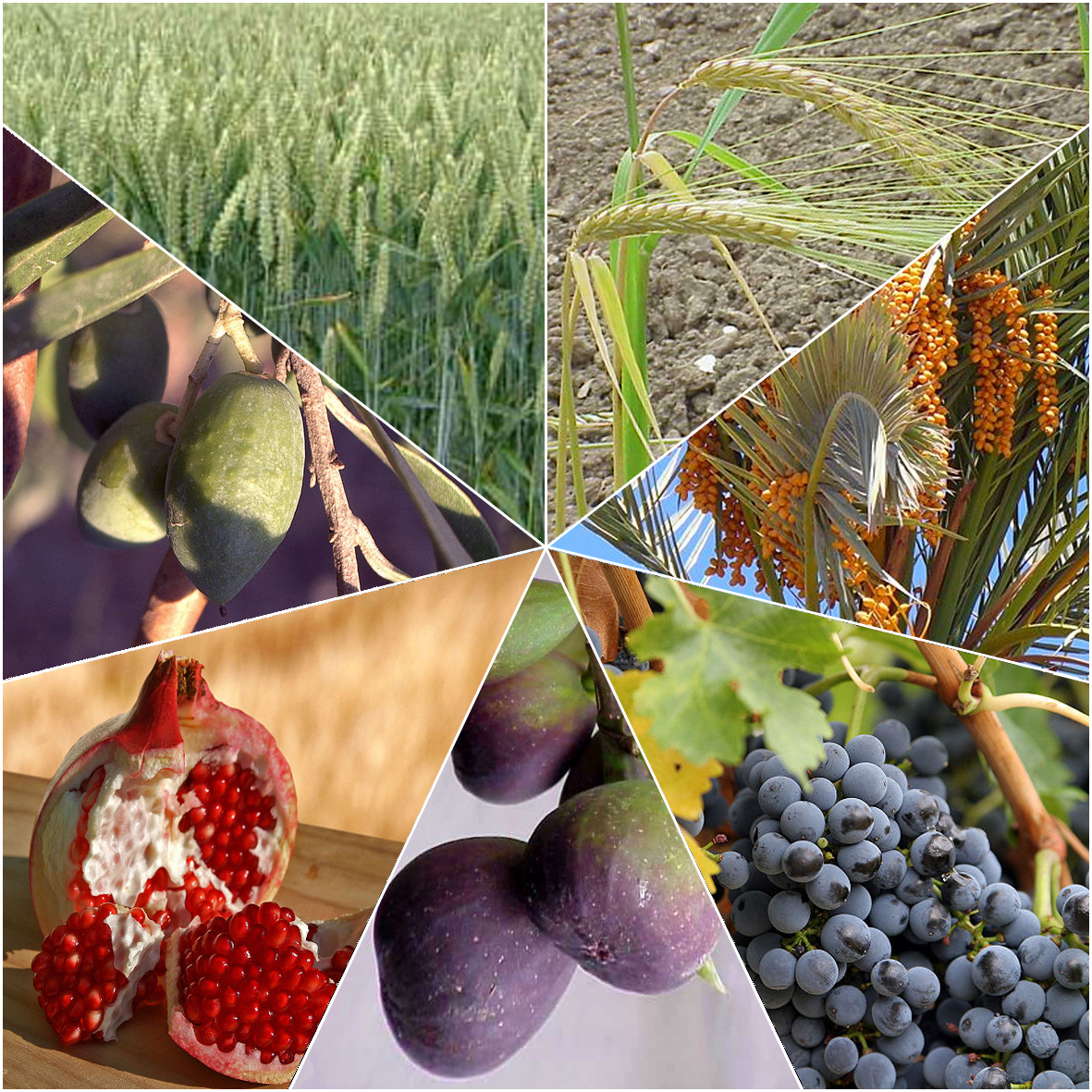|
Seven Species
The Seven Species ( he, שִׁבְעַת הַמִינִים, ''Shiv'at HaMinim'') are seven agricultural products - two grains and five fruits - which are listed in the Hebrew Bible as being special products of the Land of Israel. The seven species listed are wheat, barley, grape, fig, pomegranates, olive (oil), and date (date honey) (). Their first fruits were the only acceptable offerings in the Temple. History The Seven Species have played an important role in the food of the Israelites (later: Jews) in the Land of Israel and the religious traditions of Judaism. Many references to these basic foods can be found in Bible. The Mishna states that only first fruits of the Seven Species could be brought to the Temple in Jerusalem as offerings. Wheat fields, vineyards and olive groves are still a salient feature of the Israeli landscape today. Figs, olives, pomegranates and dates are common ingredients in the cuisine of Israel. Wheat The ancient Israelites cultivated both wheat an ... [...More Info...] [...Related Items...] OR: [Wikipedia] [Google] [Baidu] |
Bible
The Bible (from Koine Greek , , 'the books') is a collection of religious texts or scriptures that are held to be sacred in Christianity, Judaism, Samaritanism, and many other religions. The Bible is an anthologya compilation of texts of a variety of forms originally written in Hebrew, Aramaic, and Koine Greek. These texts include instructions, stories, poetry, and prophecies, among other genres. The collection of materials that are accepted as part of the Bible by a particular religious tradition or community is called a biblical canon. Believers in the Bible generally consider it to be a product of divine inspiration, but the way they understand what that means and interpret the text can vary. The religious texts were compiled by different religious communities into various official collections. The earliest contained the first five books of the Bible. It is called the Torah in Hebrew and the Pentateuch (meaning ''five books'') in Greek; the second oldest part wa ... [...More Info...] [...Related Items...] OR: [Wikipedia] [Google] [Baidu] |
Kohen Gadol
High Priest ( he, כהן גדול, translit=Kohen Gadol or ; ) was the title of the chief religious official of Judaism from the early post-Exilic times until the destruction of the Second Temple in Jerusalem by the Romans in 70 CE. Previously, in the Israelite religion, including during the time of the kingdoms of Israel and Judah, other terms were used to designate the leading priests; however, as long as a king was in place, the supreme ecclesiastical authority lay with him. The official introduction of the term "high priest" went hand-in-hand with a greatly enhanced ritual and political significance bestowed upon the chief priest of the Israelites in the post-Exilic period, especially from 411 BCE onward due to the religious transformations brought about during the time of the Babylonian captivity and due to the lack of a Jewish king and kingdom. The high priests belonged to the Jewish priestly families that trace their paternal line back to Aaron—the first high prie ... [...More Info...] [...Related Items...] OR: [Wikipedia] [Google] [Baidu] |
Pomegranate Juice
Pomegranate juice is made from the fruit of the pomegranate. It is used in cooking both as a fresh juice and as a concentrated syrup. Possible health benefits and risks Various primary studies have been conducted into possible health benefits derived from drinking pomegranate juice, but there is no strong evidence to suggest any effect in blood pressure management, cancer treatment, glucose and insulin management, or heart disease. Any potential benefits also need to be balanced against its high caloric content derived from its natural sugars. Drug interactions may also be possible. A 48-year-old man with possible underlying myopathy was uneventfully treated with ezetimibe 10 mg/day and rosuvastatin 5 mg every other day for 17 months. After three weeks of drinking 200ml pomegranate juice twice a week, he presented urgently with thigh pain and an elevated serum creatine kinase level indicating rhabdomyolysis. Doctors suspected competitive inhibition of P450 enzymes in t ... [...More Info...] [...Related Items...] OR: [Wikipedia] [Google] [Baidu] |
Pomegranate
The pomegranate (''Punica granatum'') is a fruit-bearing deciduous shrub in the family Lythraceae, subfamily Punicoideae, that grows between tall. The pomegranate was originally described throughout the Mediterranean Basin, Mediterranean region. It was introduced into Spanish America in the late 16th century and into California by New Spain, Spanish settlers in 1769. The fruit is typically in season in the Southern Hemisphere from March to May, and in the Northern Hemisphere from September to February. As intact sarcotestas or juice, pomegranates are used in baking, cooking, juice blends, meal garnish (food), garnishes, smoothies, and alcoholic beverages, such as cocktails and wine. Pomegranates are widely cultivated throughout the Middle East and Caucasus region, North Africa, north and tropical Africa, Iran, Armenia, the Indian subcontinent, Central Asia, the drier parts of Southeast Asia, and the Mediterranean Basin. Etymology The name pomegranate derives from medie ... [...More Info...] [...Related Items...] OR: [Wikipedia] [Google] [Baidu] |
Common Fig
The fig is the edible fruit of ''Ficus carica'', a species of small tree in the flowering plant family Moraceae. Native to the Mediterranean and western Asia, it has been cultivated since ancient times and is now widely grown throughout the world, both for its fruit and as an ornamental plant.''The Fig: its History, Culture, and Curing'', Gustavus A. Eisen, Washington, Govt. print. off., 1901 ''Ficus carica'' is the type species In zoological nomenclature, a type species (''species typica'') is the species name with which the name of a genus or subgenus is considered to be permanently taxonomically associated, i.e., the species that contains the biological type specimen( ... of the genus ''Ficus'', containing over 800 tropical and subtropical plant species. A fig plant is a small deciduous tree or large shrub growing up to tall, with smooth white bark. Its large leaves have three to five deep lobed leaf, lobes. Its fruit (referred to as syconium, a type of multiple fruit) i ... [...More Info...] [...Related Items...] OR: [Wikipedia] [Google] [Baidu] |
Wine
Wine is an alcoholic drink typically made from fermented grapes. Yeast consumes the sugar in the grapes and converts it to ethanol and carbon dioxide, releasing heat in the process. Different varieties of grapes and strains of yeasts are major factors in different styles of wine. These differences result from the complex interactions between the biochemical development of the grape, the reactions involved in fermentation, the grape's growing environment ( terroir), and the wine production process. Many countries enact legal appellations intended to define styles and qualities of wine. These typically restrict the geographical origin and permitted varieties of grapes, as well as other aspects of wine production. Wines not made from grapes involve fermentation of other crops including rice wine and other fruit wines such as plum, cherry, pomegranate, currant and elderberry. Wine has been produced for thousands of years. The earliest evidence of wine is from the Cau ... [...More Info...] [...Related Items...] OR: [Wikipedia] [Google] [Baidu] |
Grape
A grape is a fruit, botanically a berry (botany), berry, of the deciduous woody vines of the flowering plant genus ''Vitis''. Grapes are a non-Climacteric (botany), climacteric type of fruit, generally occurring in clusters. The cultivation of grapes began perhaps 8,000 years ago, and the fruit has been used as human food over history. Eaten fresh or in dried form (as raisins, Zante currant, currants and Sultana (grape), sultanas), grapes also hold cultural significance in many parts of the world, particularly for their role in winemaking. Other grape-derived products include various types of jam, juice, vinegar and oil. History The Middle East is generally described as the homeland of grape and the cultivation of this plant began there 6,000–8,000 years ago. Yeast (wine), Yeast, one of the earliest domesticated microorganisms, occurs naturally on the skins of grapes, leading to the discovery of alcoholic drinks such as wine. The earliest archeological evidence for a domi ... [...More Info...] [...Related Items...] OR: [Wikipedia] [Google] [Baidu] |
Sukkot
or ("Booths, Tabernacles") , observedby = Jews, Samaritans, a few Protestant denominations, Messianic Jews, Semitic Neopagans , type = Jewish, Samaritan , begins = 15th day of Tishrei , ends = 21st day of Tishrei , date = , date = , date = , date = , observances = Dwelling in ''sukkah'', taking the Four Species, ''hakafot'' and Hallel in Synagogue , significance = One of the three pilgrimage festivals , relatedto = Shemini Atzeret, Simchat Torah , alt=, nickname=, litcolor=, celebrations=, date=15 Tishrei, 16 Tishrei, 17 Tishrei, 18 Tishrei, 19 Tishrei, 20 Tishrei, 21 Tishrei, weekday=, month=, scheduling=, duration=, frequency=, firsttime=, startedby= Sukkot ''Ḥag hasSukkōṯ'', lit. "festival of booths". Also spelled Succot; Ashkenazic: Sukkos. is a Torah-commanded holiday celebrated for seven days, beginning on the 15th day of the month of Tishrei. It is one of the Three Pilgrimage Festivals ( he, של� ... [...More Info...] [...Related Items...] OR: [Wikipedia] [Google] [Baidu] |
Shavuot
(''Ḥag HaShavuot'' or ''Shavuos'') , nickname = English: "Feast of Weeks" , observedby = Jews and Samaritans , type = Jewish and Samaritan , begins = 6th day of Sivan (or the Sunday following the 6th day of Sivan in Karaite Judaism) , ends = 7th (in Israel: 6th) day of Sivan , celebrations = Festive meals. All-night Torah study. Recital of Akdamut liturgical poem in Ashkenazic synagogues. Reading of the Book of Ruth. Eating of dairy products. Decoration of homes and synagogues with greenery (Orach Chayim494. , significance = One of the Three Pilgrimage Festivals. Celebrates the revelation of the Five Books of the Torah by God to Moses and to the Israelites at Mount Sinai, 49 days (seven weeks) after the Exodus from ancient Egypt. Commemorates the wheat harvesting in the Land of Israel. Culmination of the 49 days of the Counting of the Omer. , relatedto = Passover, which precedes Shavuot , date = , date = , date = , dat ... [...More Info...] [...Related Items...] OR: [Wikipedia] [Google] [Baidu] |
Ancient Israelite Cuisine
Ancient Israelite cuisine refers to the culinary practices of the Israelites from the Late Bronze Age arrival of Israelites in the Land of Israel through to the mass expulsion of Jews from Roman Judea in the 2nd century CE. Dietary staples among the Israelites were bread, wine, and olive oil; also included were legumes, fruits and vegetables, dairy products, fish, and meat. Israelite cuisine was adherent to the dietary restrictions and guidelines of Yahwism and its later-developed forms: Judaism and Samaritanism. There was a considerable continuity in the main components of the diet over time, despite the introduction of new foodstuffs at various stages. The food of ancient Israel was similar to that of other Mediterranean cuisines of the time. Sources Information about the food of the ancient Israelites is based on written sources, archaeological records and comparative evidence from the wider region of the ancient Levant. The primary written source for the period is the He ... [...More Info...] [...Related Items...] OR: [Wikipedia] [Google] [Baidu] |
Cuisine Of Israel
Israeli cuisine ( he, המטבח הישראלי ) comprises both local dishes and dishes brought to Israel by Jews from the Diaspora. Since before the establishment of the State of Israel in 1948, and particularly since the late 1970s, an Israeli Jewish fusion cuisine has developed.Gold, Rozann''A Region's Tastes Commingle in Israel'' (July 20, 1994) in ''The New York Times'' Retrieved 2010–02–14 Israeli cuisine has adopted, and continues to adapt, elements of various styles of Arab cuisine and diaspora Jewish cuisine, particularly the Mizrahi, Sephardic and Ashkenazi styles of cooking. It incorporates many foods traditionally included in other Middle Eastern and Mediterranean cuisines, so that spices like ''za'atar'' and foods such as ''falafel'', ''hummus'', '' msabbha'', ''shakshouka'' and ''couscous'' are now widely popular in Israel.Gur, ''The Book of New Israeli Food'', pg. 11 Other influences on the cuisine are the availability of foods common to the Mediterranean ... [...More Info...] [...Related Items...] OR: [Wikipedia] [Google] [Baidu] |

.jpg)

.jpg)





